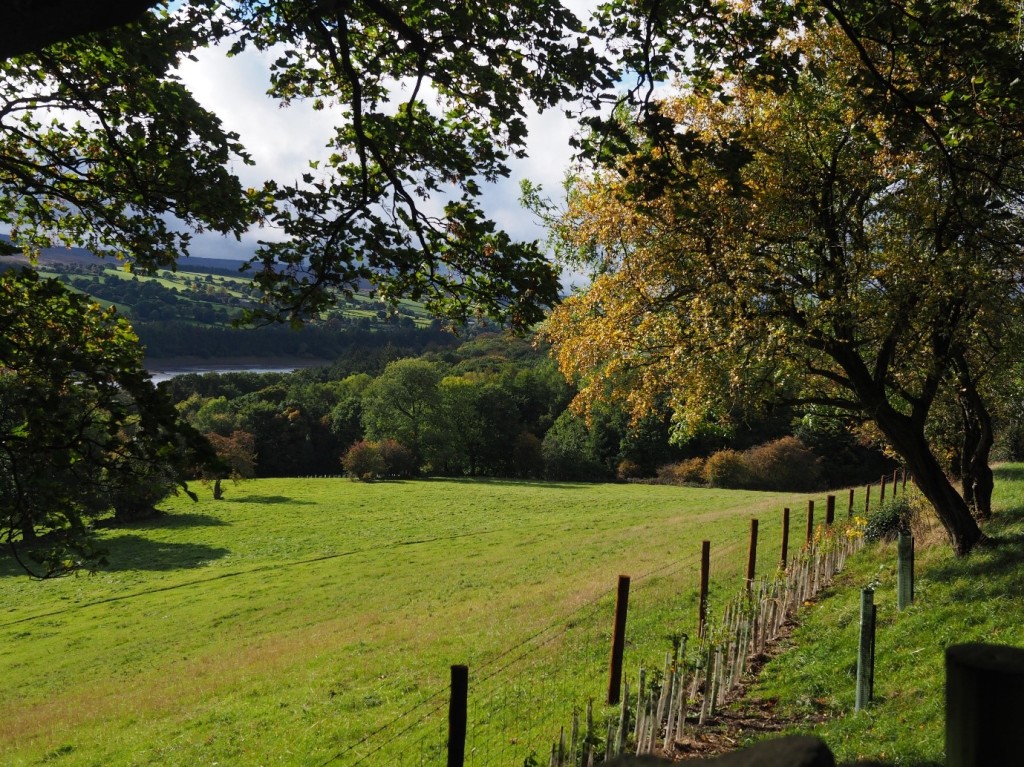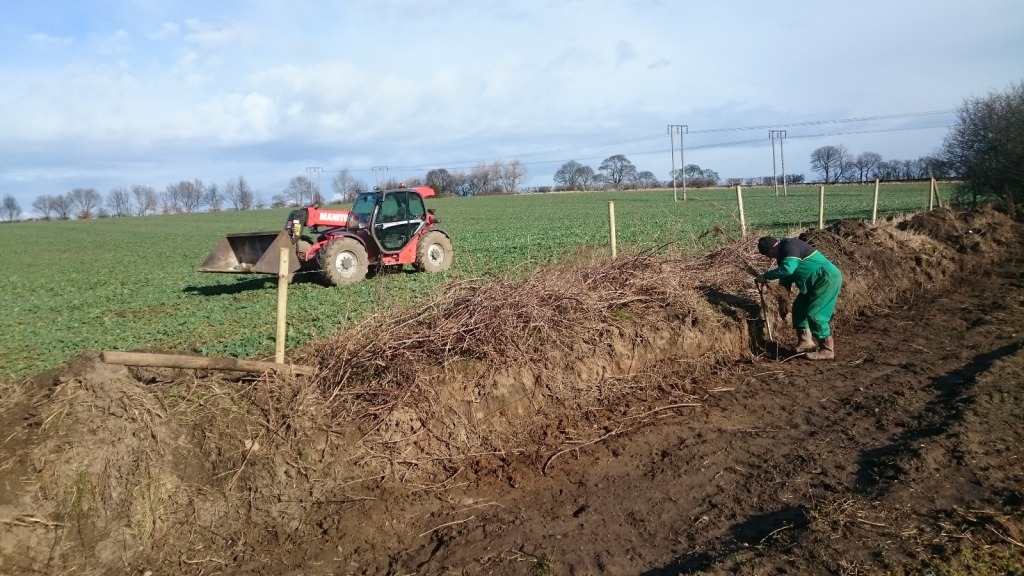
In this blog we hear from DCRT Agricultural Officer, Jenny Palmer, on how hedgerows can be used in natural flood management…
If you’ve travelled around the countryside this winter, you may have noticed that farmers and volunteers have been busy planting new and restoring old field boundary hedgerows. Hedgerows are nature’s larders, corridors, and homes; they are an important part of our natural and cultural heritage and play a vital role in carbon storage and flood mitigation. It is estimated that since the 1950s up to 50 per cent of our hedgerows have been lost through removal or neglect. This winter, farmers and conservationists across the landscapes of the Dearne and Don Valleys have worked together to help reverse this trend.
At the moment, they don’t look like much but come spring they will bud and start to burst to life. The planting is made up of a mix of Hawthorn, Crab apple, Dog rose, Dogwood, Field maple, Hazel, Holly, Rowan and Bird Cherry. This rich diversity ensures an extended flowering season for pollinators and insects, good nesting habitat for birds like yellowhammer, linnets and dunnocks, and an abundance of berries in the winter for visiting and native birds. Hedgerows benefit lots of other wildlife too: bats commute and feed along them; and mammals and amphibians take shelter beneath them, supporting species further up the food chain.
Hedgerows are also considered a natural flood management measure, as they improve soil infiltration and slow the rate at which overland flow enters the drainage network and watercourses. This also results in water quality benefits for our streams and rivers by acting as a barrier to pollutants such as pesticides, fertilisers and sediment.
Hedgerows are good for farm businesses too, providing shelter and browsing material for livestock, which improves growth rates, productivity and animal welfare. On farms where arable crops are grown, hedges reduce windspeed, can stabilise soils, retain moisture and give a home to beneficial insects, which help with crop pollination and natural pest control.

In order that they thrive, and especially given more extreme weather events, the hedges take careful establishment and aftercare. By working in collaboration, the Dearne Valley Farmers cluster group has helped to link up farmers to grants, donations, advice, and conservation volunteers.
Jenny Palmer, DCRT agricultural officer said:
Around 70 per cent of the catchment’s land is farmed so farmers play a vital role in meeting government targets on biodiversity, carbon, clean air and water. The Dearne and Don Valley Farmers are committed to taking action to recover nature and achieve net zero on their farms. By working collaboratively and with the support of funders and the conservation sector, this winter they’ve worked together to create hedgerow habitats at the landscape-scale.
This season’s planting has been generously supported by the Woodland Trust – who supplied 39,000 hedge plants enabling 6.5 kilometres of hedgerow and tree planting across the Don and Dearne Valleys. The group has also been supported by the South Yorkshire Woodland Partnership and the River Stewardship Company’s Riverlution project, whose conservation volunteers have helped farmers with planting.
Beth Thomason, Woodland Trust outreach adviser said:
We were very keen to be involved with the extensive hedgerow creation ambitions across the Don and Dearne Valley catchments. Hedgerows and hedgerow trees provide essential shelter, food, and nesting habitat for wildlife, as well as vital landscape scale connectivity. Hedgerows also benefit the economics and ecosystems on farms: they increase shelter and shade for livestock, provide wood fuel, fodder, and materials for use on the farm, improve soil conditions, and slow the flow of water. Hedgerows have been lost from our countryside due to agricultural intensification, so to see all these projects where farmers are wanting to reinstate them, is very encouraging. It was a great pleasure working with local partners to help deliver native hedgerow creation at scale.
Ann Hanson, Dearne Valley Farmers adviser said:
There is grant funding currently available via Countryside Stewardship (CS) Capital Grants, and formerly through Mid-Tier CS, to restore older hedges and plant new ones. Payments for hedge gapping up, laying, coppicing and planting new hedges are quite generous and grant funding towards new fencing to protect new and restored hedges is also available. Hedge restoration projects can be almost cost neutral using the CS funding streams, so there’s never been a better time to evaluate the condition of older hedges and consider planting some new ones as well. In addition to capital grants, the Sustainable Farming Incentive (SFI) is enabling farmers to receive ongoing payments for hedgerow condition assessment, as well as good management of hedges and hedgerow trees. The value of hedges to wildlife should not be underestimated, along with their importance in protecting livestock from our ever-changing climate.

Chris Harrap, Dearne Valley Farmers facilitator said:
We are big fans of hedgerows and have a long history of planting and laying – we now have over 25km of hedgerows across the farm. They provide real benefits, not only for the wildlife we share the land with, but for our farm business too. There has never been a better time to plant hedgerows – the grants more than cover the cost, there are often free plants and materials available too, and the act of undertaking hedgerow works can also open up funding for fencing and gates. In years to come, these hedges will be laid, giving us living fences. You could see the see the act of hedge planting as taking land out of production, but in reality, hedgerows make our farm more sheltered for grazing livestock, crop growing and gives us more resilience at a time of increasingly unpredictable weather conditions.
Chad and Lucy Stevens, Dearne Valley Farmers cluster members said:
Many hedges were ripped out here through the 1960s and 70s, and we are putting them back in – we will be putting in a total of 668 metres of new hedges this year. Our reasons for doing this are twofold. We are moving to a regenerative agriculture approach and bringing livestock to the farm. We hope over time the hedges will provide natural barriers to allow us to move more livestock with ease between fields. We have always been passionate about maintaining and enhancing wildlife on the farm and it goes hand in hand with a recent bird survey we had done through the cluster. We are keen to improve biodiversity on the farm and provide natural corridors to support their movement and better growth.

Chris Lucas, River Stewardship Company skills manager said:
We had a brilliant day visiting Horncastle Farm with some of the volunteers from the River Stewardship Skills Scheme. Lucy the farmer gave us a mini tour of the farm before starting the works, and some of the group got to hold lambs! The volunteers and Max, who is doing an apprenticeship at Riverlution, worked alongside Jenny from DCRT and Lucy the farmer to plant over 500 tree whips with canes and guards to create a hedge along the field edge.




You must be logged in to post a comment.